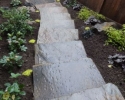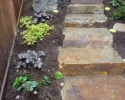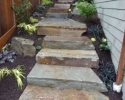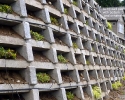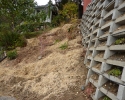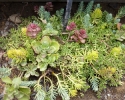For area gardening fans, it’s Show Time
By MARY EVITT, Skagit Valley Herald Staff Writer

Designer Sarah Lowell Bishop uses native plants and rocks to retain water and soil on her hillside garden in Bow. Her talents will be showcased in a display garden at the Northwest Flower and Garden Show Feb. 4-8 in Seattle. At top, hens and chicks grow in a retaining wall. Scott Terrell / Skagit Valley Herald
Sarah Lowell Bishop treats rainfall playfully and as a gardener’s friend. Drought can seem as distant as the desert during Skagit’s rainy season, but Bishop’s landscape designs are mindful of the extended dry spells that stress plants and send water bills spiraling.
Gardeners can view innovative ways to gather and retain rainwater in a lush garden Bishop helped design for the Northwest Flower & Garden Show. “Harvesting the Rain Garden” is one of 27 full-size gardens on display Feb. 4-8 at the Washington State Convention Center in Seattle.
Bishop’s fertile imagination plants a number of ideas in the “rain” garden or for use in any Northwest landscape for that matter.
A Bow resident, Bishop collaborated with designer Cameron Scott of Seattle.
“With rain eight months of the year, why not enjoy it — not dread it?” Scott said.
The design duo dispel notions of ugly rain barrels collecting drain water and breeding mosquitoes Their garden demonstrates attractive and practical ways to collect rain from the roofs of houses and outbuildings. Rainwater collectors are enclosed, some underground. The water flows through aqueducts in a “living wall” of plants to a pond and cistern.
Between 20,000 and 30,000 gallons of water can be gathered for free in a year, Scott said.
Rainwater is nature’s gentle plant moisturizer because it hasn’t been chlorinated, Bishop said.
In designing the garden, Bishop chose plants native to the Northwest, along with a bounty of edible plants. This type of gardening is called sustainable agriculture or permaculture because it has low impact on the environment.
Bishop advises gardeners to stay away from exotics and choose plants that adapt well to their gardens; once established the vegetation won’t devour excessive amounts of water. And the unexpected benefit for busy people is low-maintenance gardening, she said.
The rain garden is alive with critters as well as plants. The designers have included chickens and a worm farm. Artful use of recycled materials such as glass, wood, steel and bricks are worked into the landscape.
Bishop met Scott when they were visiting the Caribbean, later starting a landscape business in Seattle that incorporated some of the clever ways the islanders utilized to make the most of limited natural resources in the fragile environment with which they co-exist.
Scott said the islanders gathered and stored rainwater in cisterns for drinking and bathing. Gray water (waste water that doesn’t include sewage) was recycled into the garden.
The duo operated Exteriorscapes until Bishop got married in 2002 and moved from Seattle to five acres atop Bow Hill.
She discovered an abandoned 1930s Ford flatbed truck on the property. Scott created a display for the Northwest Flower & Garden Show that year with the truck jazzed up fancifully like a gypsy wagon, bedazzling visitors with its placement in the center of the plantings. After the show, Scott gave Bishop the refurbished truck as a wedding gift.
Now she has tucked the truck into the tall evergreens on Bow Hill that fringe the hillside gardens she is building as a future showcase for her talents. She owns and operates Lowell Garden Design in Bow.
Chunks of red-hued quarry stone form retaining walls to create tiered flower beds on the slopes, the stone replacing the tarred railroad ties that once flanked walkways. Succulents, creepers and other low-slung plants are inserted into cracks in the wall. Indigenous plants, along with transplants from areas with similar climates, are interspersed in beds that blend into the setting as if part of the natural landscape.
Bishop really cares about plants’ welfare. From 1998 to 2001, she was president of PlantAmnesty. The nonprofit organization educates homeowners and professionals about careful pruning and environmentally friendly gardening techniques.
PlantAmnesty is a regular at the garden show in Seattle. The group typically grabs visitors’ attention with at least one tall tree. It is always a limbless torso, a nightmare of hacked-off vegetation that’s slowly dying because all of its leaves and branches were massacred.
Bishop not only knows how to save plants lives, she has the recipe for keeping them healthy.
She whips up batches of compost tea, infusing and brewing different varieties. The tea beverage is applied to the soil to enhance growth, improve soil quality and help suppress disease. A sip of tea benefits everything from veggies to roses to lawns, she said.
Recycling is a key ingredient in Bishop’s hillside garden. Her worm farm converts household waste into a soil additive, a treat for her favorite plants. Her compost heap breaks down garden waste to return nutrients to the soil.
Even leftover cement didn’t go to waste thanks to Bishop’s inventive mind. The cement rises to within about 4 inches of the lip of an old bucket. Pebbles decorate the surface, creating a water dish for visiting birds and animals.
It’s possible to garden in harmony with Mother Nature and have fun by letting the imagination roam freely.
“Think of ways to use resources in creative, fun and clever ways,” Bishop said.
This article appeared February 1, 2004 in the Skagit Valley Herald.
